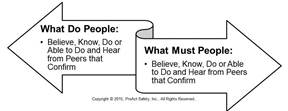Do You Really Know Your Safety Culture?
It is ineffective to make your plans without knowing where you are going and what success looks like, correctly defined.
Theoretically, there is no such thing as a safety culture, but every company has one. Safety is part of all company cultures--great, good, or bad--and we use the term "safety culture" to give it an improvement focus and bookends to manage within. To use or not use the term safety culture is an irresponsible and pointless debate. Beliefs and behaviors specific to desired safety outcomes already exist and shape decisions within an organization. Safety cultures exist; how well do you know yours?
Some believe safety culture as a stand-alone concept is wrong, as it implies safety is in addition to the operational culture. Cultures change when group behaviors and values change; thus, there must be specificity regarding which beliefs, behaviors, and experiences to take on. Depending on the maturity of safety's role in company priorities and values, such as our best-performing clients, this argument has merit.
To say we shouldn't view safety as separate from occupational culture when it often is in many companies, is painting a picture of Utopia without a plan to get there when Dystopia is the current reality. Considering your current situation, is safety a shared responsibility and interest or a delegated priority and something to be done in addition to revenue-producing activities? What is common regarding safety?
The way we do things around here, why we do what we do, and what people do when no one is looking are artifacts of culture. Culture is what's common within a group. Regarding safety, what beliefs, knowledge levels, decisions, observable behaviors, and stories overheard from peers are common within your organization? What needs to be? How clear are you on where the gaps are and the reasons for their existence?
Beliefs enter your occupational culture with each new hire or contractor engaged. Are they understood, corrected or confirmed, and aligned prior to the start of work? Or are they allowed to be exposed to others within the culture when work begins? When hiring an influential, well-liked individual that has a strong, positive belief around the importance of safety, this could have a positive impact on others within the group. An entering negative impression about safety also could have a carry-over effect.
If an organization is unaware of the current common beliefs, decisions, behaviors, experiences, and confirming or conflicting story-telling, the doors remain wide open to influences from both inside and outside of the organization. Imagine trying to win a battle, grow market share, bring a product to market, and improve quality or customer engagement scores without an understanding of the existing knowledge, beliefs, capabilities, and competencies of your personnel and resources. This is the absurdity facing many companies as they attempt to improve safety performance and culture.
In the aforementioned example, it is ineffective to make your plans without knowing where you are going and what success looks like, correctly defined (achieve success vs. fail less). Again, there is no difference when planning for safety improvement. Executives, not those to whom safety has been delegated as a job title or responsibility, must delineate what is first vs. second to improve safety in a way that supports and enables business goals.
To understand the existing culture, it is seemingly logical to begin to assess first. Hundreds of personally led safety culture assessments validate this is the wrong first step because, other than expert opinion, there is no business direction to measure against. If engaging an expert, promptly show them the door if the only comparison is against other companies. No two will ever be alike. Companies must first define the desired future state (business and safety) before looking at their current reality. What is possible for one company is impossible for another. Only after all of this is understood can gaps be correctly identified. Otherwise, who decides what is a gap versus what is a competitive advantage? (See the figure below.)
 To improve its safety culture, an organization must first define what is desired, then assess the gaps that exist and prioritize what could be addressed this year and what must be deferred to subsequent years. Strategy is a living concept that changes, sometimes regularly. Leaders must make the difficult but important tradeoffs determining the best use of resources this year and what to set aside for later years.
To improve its safety culture, an organization must first define what is desired, then assess the gaps that exist and prioritize what could be addressed this year and what must be deferred to subsequent years. Strategy is a living concept that changes, sometimes regularly. Leaders must make the difficult but important tradeoffs determining the best use of resources this year and what to set aside for later years.
A leader will never truly know his or her current culture, safety or otherwise, until first determining what people must know, believe, do or are able to do, and what stories they should hear from their peers that validate these important priorities. Leaders may think they know their current cultural reality, but if they don't know where the culture must go to support business objectives, how useful is only knowing the starting point?
This article originally appeared in the June 2015 issue of Occupational Health & Safety.